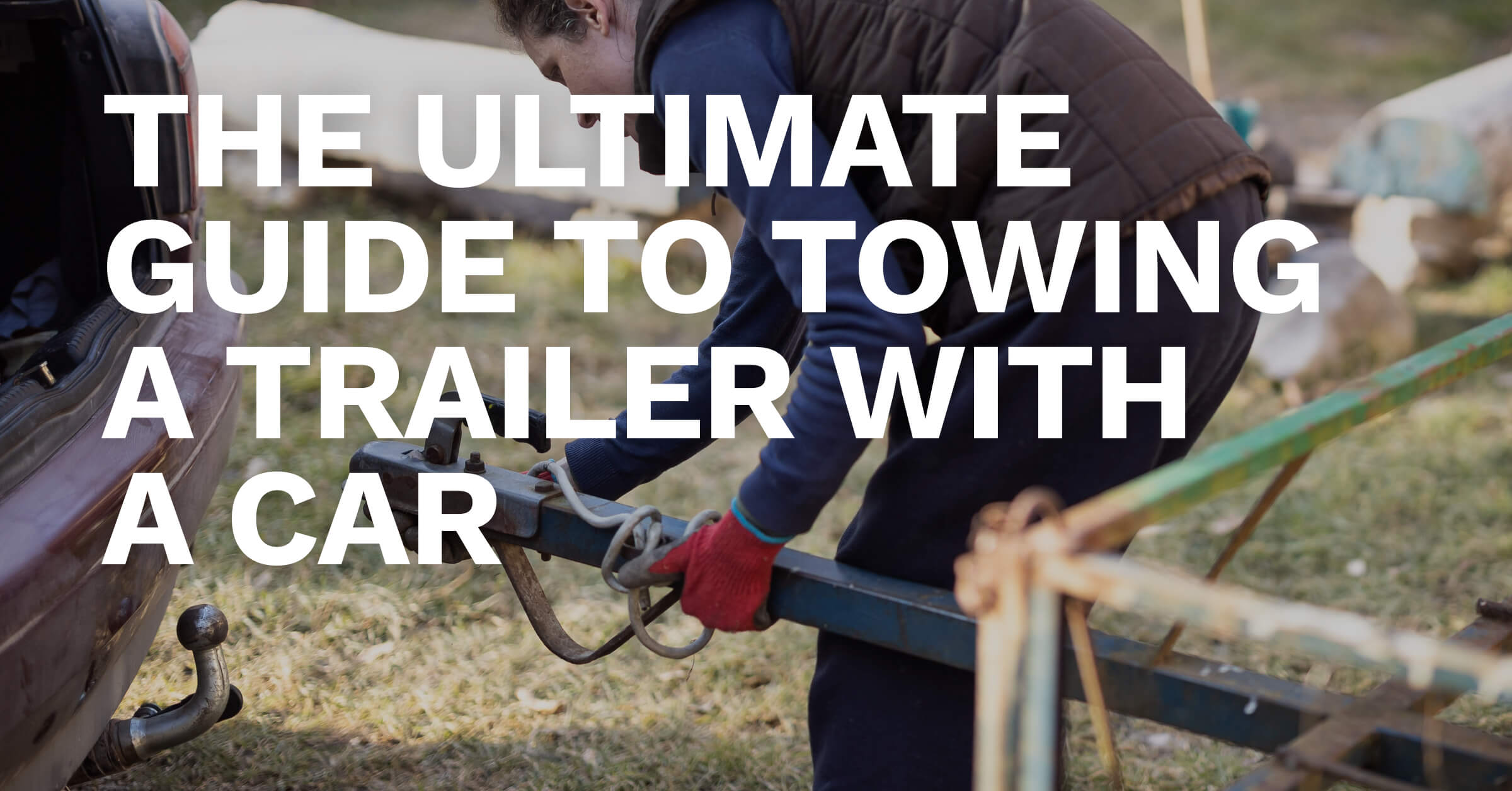
The Ultimate Guide To Towing a Trailer With a Car
If you're looking for advice on towing a trailer with a car you've come to the right place. There are tons of reasons you may need some extra room on the road. Whether it's for a camping trip, towing an ATV or motorbike, or moving building materials from A to B. You'll need to know the rules around towing a trailer with a car and we're here to help you get where you need to be safely.
Here we'll give you the rundown of everything trailer related. From weight restrictions to helpful tips on choosing the right towbar for your vehicle. We'll offer advice on:
- The laws around towing with a car. Which includes:
- How much can I carry when towing with my car?
- Do I need an extra licence to tow my trailer?
- Are there width and length restrictions for towing?
- Safety checks before towing with your car
- Other related requirements and tips on towing and
- What towbars are available for towing a trailer with a car
The laws around towing with a car
Although it is no longer a legal requirement to pass a test for towing a trailer with a car, there are laws and regulations you must follow. These include the carrying capacity and size restrictions of a trailer towed by a car.
How much can I carry when towing with my car?
Every car has a maximum weight it can tow with a trailer and this is their 'maximum authorised mass' (MAM), as listed in the car's handbook or spec sheet.
You can also find your vehicle's 'gross train weight' (GTW) on the vehicle identification number (VIN) plate on your car. This is normally found under the bonnet or inside the driver's door. The GTW is the weight of a fully-loaded car plus a fully-loaded trailer. It should never be exceeded.
If your VIN plate doesn't list a train weight, your car cannot be used for towing. Find out more about vehicle weights.
Do I need an extra licence to tow my trailer?
If you have a driving licence, you can tow a trailer behind your car without the need for an extra licence or certificate. To understand how much you're licensed to tow, you'll need to know the MAM of your specific car and the type of licence you carry.
The amount you can tow will vary depending on when your driving licence was issued. If you received your driving licence before the 1st of January 1997, you can drive with a MAM of up to 8,250kg. However, if you received your licence after the 1st of January 1997, you can tow a trailer weighing up to 3,500kg MAM.
If you're looking to tow a combined weight more significant than the MAM allowed on your licence, you must apply for a provisional licence for a medium-sized lorry and trailer, pass the lorry theory test and pass the C1+E driving test. Achieving all three allows you to drive vehicles and trailers with a combined weight of up to 12,000kg MAM.
These are the most up-to-date specifications since the new towing rules on 16th December 2021. Before this change, drivers who passed their test after 1997 had to take additional training and pass a car and trailer test if they wished to tow a load heavier than 750kg. However, this test is no longer required.
Are there width and length restrictions for towing?
As with the weight, there are also maximum trailer sizes for any towing vehicle. The maximum width for any towing vehicle is 2.55 metres and the maximum length for a trailer towed by a car weighing up to 3,500kg is 7 metres.
Safety checks before towing with your car
Before you head out, there are some checks you should perform for some peace of mind, and there are some helpful tips and towing knowledge you should learn that will come in handy. The last thing you want is an issue to occur once you're already on the road.
- You must fit extended towing mirrors if your rear visibility is obstructed by your load. If you fail to apply these mirrors, you can be fined up to £1,000 and receive 3 penalty points on your driving licence
- A matching number plate must also be fitted to your trailer at all times
- Always check your lights first, to make sure that your brake, indicators and rear lights on your trailer all work properly before you start your journey
- Check your nose weight, it should be about 10-15% of your load. If this is incorrect the trailer may start to sway or snake, which is extremely dangerous
- Take turns as wide as possible, this is to avoid clipping any obstructions that you may not be aware of, including curbs
- Your stopping distance will be increased when you're carrying a heavier load than the car alone so always leave extra room in front of you when driving
Other related requirements and tips on towing
There are some other requirements you should consider when planning to tow a trailer with your car. For example, if your trailer weighs 750kg or more when it's fully loaded, it must be fitted with a braking system that's in good working order.
The simplest way to work out your car's maximum towing capacity is to subtract the MAM from the GTW. Your car's towing capacity will be the total remaining after the car's weight has been removed. When you know this figure, it's important to then add the weight of your load, like luggage or a tent. If you need help working this out, you can buy a towing scale.
No matter what you're towing, you must never exceed the car's maximum towing capacity or the trailer's MAM. These should always be treated as absolute limits and it's best to be sensible by staying below them.
Although a separate test is no longer a requirement for towing a trailer with a car, you can take optional driving lessons with a trained instructor before towing for the first time. Alternatively, there is comprehensive information on how to tow a trailer on the national standard for driving cars and light vans and in-depth discussion as to why learning to tow is important.
What towbars are available for towing a trailer with a car?
If you're ready to purchase a towbar for your car there are some things you'll need to know. For example, it must be type-approved - meaning it has been approved for use in the UK and EU and that the towbar is suitable for your specific vehicle. However, this doesn't apply if the vehicle was first used before the 1st of August 1998.
At Witter, we sell a range of towbars suitable for use on trailers. Sometimes it's down to personal preference on the appearance, other times your choice of towbar can be decided on how often you plan to use it. Our range of towbars consists of the following:
Fixed Flange: The towball is permanently attached to your vehicle's faceplate. Ideal for serious towing, such as trailers and other vehicles.
Detachable Flange: This towbar is just as versatile and robust, with the added benefit of being removable. Perfect for seasonal camping if you only use a towbar during this time.
Fixed Swan Neck: The sleeker, swan neck design is more aesthetically pleasing. However, if you're planning to use bikes as well as a trailer, know you can't tow and carry bikes at the same time with this towbar.
Detachable Swan Neck: With a similar appearance as the fixed swan neck, you can also remove this towbar when you're not towing. Ideal for the summer if you only plan to tow during this time. However, like the fixed swan neck, you can't tow and carry bikes simultaneously.
Retractable Towbar: This towbar can be folded out of sight in a matter of seconds. It offers the same advantages as the detachable towbars, but when the camping season comes around there's no need to reattach this towbar.
You can check out our range of towbars today and see what works for your trailer.
Hopefully, this guide has given you all you need to know about towing a trailer with your car. Whether you're gearing up for the camping season or moving furniture from A to B, it's a great idea to get clued up on the different requirements of each trip and to stay in the know when it comes to towing regulations.
If you need advice on how to tow another car with a trailer, check out the rules for towing a car behind a motorhome that can help you make informed decisions on the way you tow. There you can also find valuable tips on which towbars are best for towing with a motorhome. Alternatively, head to our other blog if you'd like to learn more about towing a boat. There you'll find restrictions surrounding boat towing, including speed limits and helpful tips for manoeuvring the extra load.

